![]()
![]()
![]()
Use LEFT and RIGHT arrow keys to navigate between flashcards;
Use UP and DOWN arrow keys to flip the card;
H to show hint;
A reads text to speech;
41 Cards in this Set
- Front
- Back
|
How are carbs absorbed?
|
Begins in the mouth with amylase and ends in the small intestine by entering the blood stream and molecules such as glucose then travel to the liver via the portal vein.
|
|
|
How are proteins absorbed?
|
Begins in the stomach and ends in the small intestine. Break down to AA's before absorption.
|
|
|
How are lipids absorbed?
|
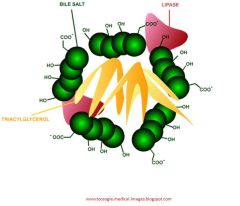
Begins in the upper duodenum of the small intestine after reaching the bile and lipase. Break down to fatty acids and are transported across the membrane, reformed to triglycerides. They enter lacteals. form micelles.
|
|
|
Lipid transport
Lipase E.R. |
Bile + fat = micelle
micelles are stabilized droplets of fat. Lipase breaks these down and then they enter the E.R. become triglyceride again. |
|
|
Pathway for inhalation/exhalation
|
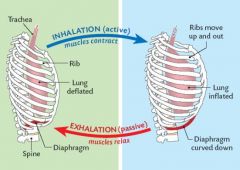
mouth to pharynx to larynx to trachea to bronchi to bronchioles to alveoli
|
|
|
what is tidal volume?
|
volume of air displaced between normal inspiration and expiration when extra effort is not applied.
|
|
|
Reserve Volume is the extra volume of air than an individual can exhale/inhale if not ________________?
|
breathing to full capacity
|
|
|
The volume of air that is remaining in the lungs after max exhalation is?
|
Residual volume
|
|
|
Vital Capacity is the the volume equal to______-________?
|
TLC-RV
total lung capacity - residual volume |
|
|
Transcription:
Location? Products? |
In Eukaryotes Transcription is in the nucleus
(RNA polymerase required) Prokaryotes is in the cytoplasm products are mRNA, tRNA and rRNA |
|
|
Translation:
products: Where it takes place in pro/eukaryotes? |
Prokaryotes: cytoplasm
Eukaryotes- ribosomes on E.R. Ribosomes required |
|
|
This type of RNA binds to mRNA near AUG start codon
|
tRNA
proteins are the products of translation |
|
|
DNA replication: DNA is read in the ____' to ___' end? and synthesized the other direction.
|
read 3' to 5' and synthesized 5 to 3
|
|
|
DNA ligase does what?
|
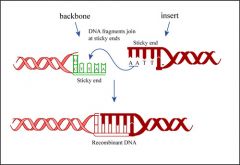
It re-anneals the semi-conservative strands and joins Okazaki fragments of the lagging strand.
|
|
|
Which enzyme provides the starting point for DNA polymerase?
|
Primase
|
|
|
This enzyme lengthens telomeric DNA by adding repetitive nucleotides. without this strands will become shorter and shorter at a faster rate.
|
Telomerase
|
|
|
There are three types of DNA replication, semiconservative, conservative, and dispersive.
|

Semiconservative are the only biologically relevant.
|
|
|
DNA Base Pairing: just tell me which bind to which in RNA and DNA and how many H-bonds they have
|
A-T in DNA and U replaces T in RNA 2 H-bonds
C-G in both DNA & RNA joined by 3 H-bonds |
|
|
What are four parts of a body that are included in the integumentary system?
|
Hair, nails, oil glands, sweat glands
antlers and claws in animals |
|
|
what are 7 functions of the Integumentary system? actually a couple are:
1. protection 2. excretion what are the others? |
3. thermoregulation
4. environmental/sensory input 5. innate immunity 6. blood reservoir 7. vitamin D synthesis |
|
|
The Reflex arc has 5 elements:
Receptor to_______ association neuron _________ effector muscle |
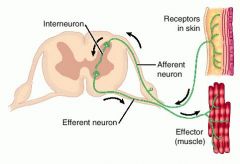
sensory neuron, motor neuron
|
|
|
Skin: The epidermis has three cell types:
|
avascular, dead, and keratinized cells
|
|
|
What is contained within the dermis?
what type of tissue is the dermis? |
blood vessels, hair follicles, sebaceous glands (oil), sweat glands, and nerve endings.
connective tissue |
|
|
What happens to the blood vessels when we get hotter?
|
move closer to the surface and dilate. constrict and move more to the center of the body when cold.
|
|
|
Platelets and clotting factors:
Platelets are fragments of ___________ ? __________ cleaves to fibrinogen which goes to ________, an insoluble molecule that holds the clot together |
megakaryocytes
Thrombin, fibrin |
|
|
two anticoagulants talked about?
|
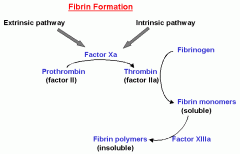
heparin and antithrombin III
|
|
|
what are the advantages of skeletal muscle being multi nucleated?
|
Enables anything to synthesize more proteins.
|
|
|
Which type of muscle is voluntary, striated and multinucleate?
|
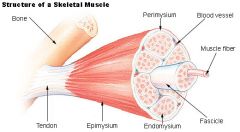
skeletal muscle
|
|
|
tendon binds muscle to ___________?
ligaments connect bone to __________ ? |
bone
bone |
|
|
Basic anatomy of the muscle: from largest to smallest parts?
|
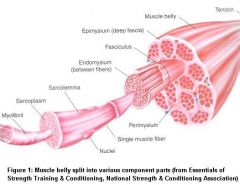
|
|
|
which part of the muscle sequesters Ca2+ away from sarcomere prior to contraction?
|
The sarcoplasmic reticulum
|
|
|
What is the order of events in muscle contraction and relaxation?
|
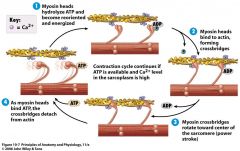
which band doesn't change length>
|
|
|
_______ filaments are major filaments of the I band and go into the A band.
within the A band is the ________ zone and inside that zone is the ________ line. |
Actin filaments
H-zone, m-line |
|
|
What is the biggest single elasticated protein in nature that provides binding sites for other proteins?
|
Titin
|
|
|
Interaction between actin and myosin occur in what band?
|
The A band
|
|
|
Thick filament= tails of _________
thin filaments = _____________ |
tails of myosin joining together are thick filament
G-actin----ATP |
|
|
What are the 5 steps of muscle contraction-relaxation?
1-Depolarization of __________ 2-opening of the _________ Ca2+ channels 3-increase in __________ which interact with ________ 4- Confirm. change in tropomyosin exposing actin binding site. actin and myosin bind and wooolaa |
1- sarcolemma depolarization and transmission of action potential through T-tubules
2. sarcoplasmic reticulum 3. increase in cytosolic Ca2+ concentrations which interact with troponin. |
|
|
what neurotransmitter is used at a neuromuscular junction?
|
Acetylcholine (somatic junctions)
|
|
|
What bonds to inactive actin?
|
tropomyosin
|
|
|
when calcium is released from the S.R. it binds to?
|
Troponin
|
|
|
If no ATP is present with myosin then __________
If no Ca2+ is present? |
myosin heads cannot detach from the actin and we get rigor. "rigor mortis" stuck in contraction.
Lack of contraction- flaccidity. |

